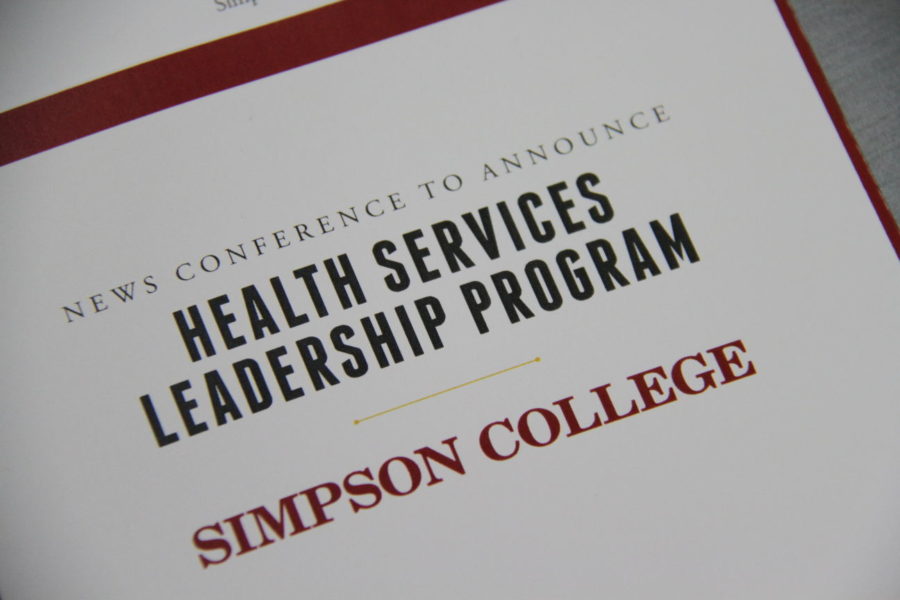Simpson undergoes major changes
November 23, 2015
Simpson College offered two new majors this fall to students while phasing out two old majors.
Health Services Leadership is a program that Business and Economics Department Chair Mark Juffernbruch has been in charge of in combination with former Simpson College Athletic Director John Sirianni.
“It’s what they used to call hospital administration,” Juffernbruch said, “but our program is brand new, designed from the ground up. It really involves health services all the way from wellness and physical fitness to end-of-life care.
“It’s the entire spectrum of health services as opposed to just hospital administration. The breadth and integration that takes place in how we deal with people healthy and sick has completely changed.”
According to Dean Steve Griffith, the decision to implement this new major has been in the works for the past two to three years.
“People felt there was there was a need out there in this area for people who are educated to be leaders in this area.” Griffith said. “The idea is that it will serve both students and the community and it’s going to draw new students to us. Money from these donors was put together to help fund the salary and expenses of the program. It’s going to be an all-upside for students.”
Jacy Downey, assistant professor of health services, has been appointed to direct the new health services leadership major.
In addition to health services leadership, Simpson has also added a management information systems major as a part of the continued learning program on the Ankeny campus.
Todd Little, assistant professor of computer science, is currently serving as the director of the Hawley Academic Resource Center and recently completed a doctorate degree in the area.
Since he displayed particular interest in taking on that program, he was moved from his position at the Hawley Center to Ankeny to lead and direct the new major.
Simpson faculty and administrative staff are enthusiastic about the changes that are taking place with the new majors, but marketing and art education have been removed from Simpson’s list of offered majors.
“Whenever we take away a program, it’s important that we put into place what we call a teach-out plan,” Griffith said. “The idea is that no student should be cut short if we drop a major. So we phase it out over time, stop accepting new students into the programs, so anyone who was promised it wouldn’t be disadvantaged.”
“Marketing was dropped with the students in mind,” Juffernbruch said.
“The department made this decision because just as with any business, we have to deploy our resources in the places we think will make us the strongest,” he said. “I think we wanted to circle in on the programs that we felt were going to be the most beneficial to our students. Overall, I think it will strengthen the department and opportunities available for our students.”
Juffernbruch stressed that many opportunities and courses will remain a part of the Simpson College experience including Simpson’s new entrepreneurial business club, the Collegiate Entrepreneurs’ Organization.
The art department also noticed a decreasing number of students interested in pursuing art education over recent years. Therefore, they made the decision to shift their focus and efforts towards graphic design, which they hope will be enhanced as a result of cutting the art education program.
“We’ve been in a position where we have limited resources at our disposal and yet we want to see growth in our department and make it stronger,” Art Department Chair Gabrielle Rose-Curti said. “We’re small. To do three majors really well in a realistic scenario, we can’t. It really appears that the graphic design area is where we need to focus more of our attention to consolidate as a department. That unfortunately came down to dealing with what we have.”
According to Rose-Curti, this decision was made in response to student surveys and outside evaluators from other academic art programs.
“Graphic design is the most popular major even right now, yet it was the one area where we saw the most dissatisfaction with,” Rose-Curti said. “Having an adjunct who’s teaching the graphic design courses for a major becomes problematic because we have these professors leaving and we just weren’t seeing that consistency, both pedagogically and in terms of content. We felt like we really needed to respond to that on some level.”
According to Griffith, these changes are a part of what is required to accommodate the needs of students as well as the current job market.
“At a place like Simpson, the curriculum is changing all the time,” he said. “We’re adding majors, we’re subtracting majors, and departments are changing up what constitutes a major. You have to keep the curriculum organic and dynamic, always changing and adapting.”





